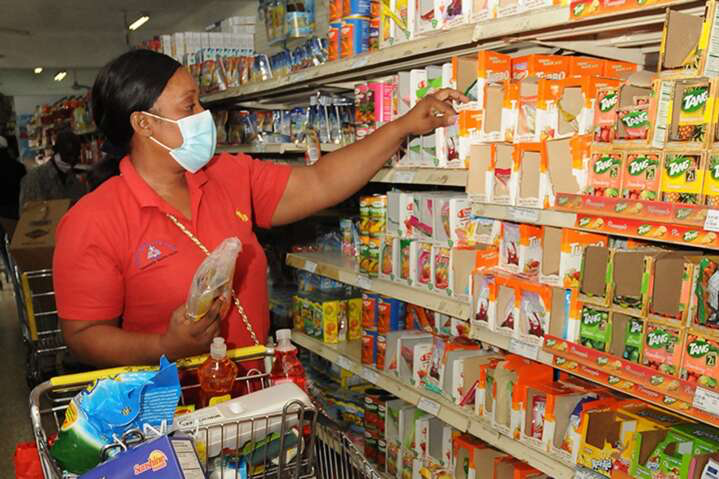
Shipping costs and logistics challenges which sent prices higher last year are coming down but consumers hoping to get relief at the supermarket will have to wait a while longer, as raging inflation globally is expected to keep prices sticky upwards for the foreseeable future.
Shipping costs, which bore some of the blame for price increases in the last year, have since receded to pre-pandemic levels of around US$3,000 per 40ft container, down dramatically after flirting with US$20,000 per 40ft container last year. At the same time the prices of commodities — wheat, rice, corn, edible oil and fuel oil — all of which went up at the start of the Russia-Ukraine war, have declined between 20 per cent and 45 per cent from their 2022 peaks.
So what about consumer prices in Jamaica?
“The cost of goods themselves has gone up because of global inflation, so while shipping costs have gone down the actual cost of the goods have gone up significantly,” Don Wehby, chief executive officer of GraceKennedy, a food and financial conglomerate, told the Jamaica Observer in an interview.

Wehby explained that there are other issues preventing costs from declining, including higher input prices.
“[For] our Tropical Rhythm, the [cost of the] glass bottles are up probably close to a 100 per cent,” he pointed out, due to an ongoing glass bottle shortage which impacted the availability of many other bottled products for local manufacturers.
Wehby also pointed to inflation levels in GraceKennedy’s largest markets — the UK and the USA. The cost of living increased sharply across the UK during 2021 and 2022, reaching 11.1 per cent in October 2022, a 41 year higher, before easing slightly to 10.1 per cent in February, though still significantly above the 2 per cent target which the British Government sets for the Bank of England to achieve. In the US the picture is pretty much the same. An inflation rate at 6.04 per cent at the end of February was well above the target of 2 per cent the for which the Federal Reserve aimed.
Wehby said these figures need to be watched closely, pledging to cut prices for local consumers as soon as is possible.

“You have GraceKennedy’s assurance that once there’s any opportunity to pass on the benefits of a price reduction to our consumers, we’re going to do that because we realise that it’s a market-driven economy — but we just have to watch the global inflation numbers very carefully,” he noted.
On the other hand, Seprod said it has been reducing prices to retail consumers and manufacturers since September 2022.
“Cooking oil price has had three rounds of price reductions, approximately 7 per cent to 11 per cent overall. Flour has had two rounds of price reductions [averaging] 5 per cent to 6 per cent. Condensed milk was reduced by 5 per cent to 6 per cent as recently as last week,” Richard Pandohie, CEO of Seprod, said in written responses to Business Observer queries.
“As our replacement inventory becomes less expensive, we will keep passing [more reduction] onto our consumers,” Pandohie continued.

Still, like Wehby, he said Seprod is still seeing an increase in input costs.
“Up to today [Monday] I received notification of an 8 per cent increase in packaging cost for a product that already had a 5 per cent price increase in October last year. There is still an elevated level of inflation risk globally — due to geopolitical tensions, weather-related challenges in key agriculture belts etc — and we have to be watching these closely as it could impact our input cost,” he said.
At Derrimon Trading higher interest costs have been cited for keeping prices elevated.
“When interest rates go up it is a cost to business, and businesses are going to try to recover some of those costs,” Derrick Cotterell, chairman and CEO of Derrimon Trading, explained.
Cotterell said there have been improvements in prices, especially for meat products, though he cautioned that shipping and supply chain issues are not fully solved.
“There are still some legacy issues, particularly out of Asia, but all over the world still it’s getting better but it’s not fully resolved. China itself has just really been opening up so there are still a lot of back orders. Things are better but I wouldn’t say that they are totally solved in terms of supply chain issues and shipping,” Cotterell revealed.
For a lot of imported products, particularly those coming out of North America, Pandohie says the reverse is true as prices have gone up 7 per cent to 20 per cent due to inflationary pressure in those markets.
“For goods coming out of China, the dramatic drop in shipping cost has made those products more cost competitive, for example, appliances and furniture. Where possible, companies are exploring switching from North America and European suppliers back to Asia, which is the reverse of what happened during the pandemic,” Pandohie explained.
He added that an increase in wages, due to a tightening labour market, and the effect of the drought have also driven up local agricultural products without an increase in productivity, which worsens Jamaica’s competitive position.
Overall though, manufacturers have expressed optimism that consumers will see a reduction in the price of their goods, but couldn’t say exactly when that will happen.
“Based on the trends that we’re looking at on our forward purchasing, we think that, certainly in the main market that we purchase from, we’re noticing inflation is actually moving in the right direction, meaning it’s moving down but slowly,” Wehby pointed out.
“I am hopeful that prices will keep coming down but this depends on companies improving their productivity, reviewing their supply sourcing and, of course, consumers need to shop around to ensure businesses are kept on their toes due to competitive pressure,” Pandohie stated.
Source: Jamaica Observer
March 22, 2023




































